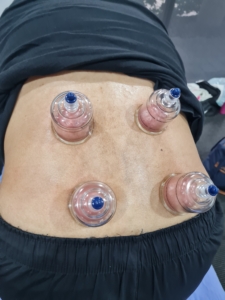Functional Release Cuppping – what is it and how can it help you?
Most people have heard of cupping therapy, a lot of people have had it done in the past. And many of us have seen those weird round bruise-like markings on people’s shoulders and arms. Especially on athletes which may explain why there is a renewed interest every four years in what cupping is. Olympics anyone?
There are a few theories on how cupping may help. Many of them are born from Eastern Medicine and words like stagnancy and blockages are used. Chinese Medicine is fascinating and amazing, but it is not my field of expertise so that’s all I have to say about how that theory of healing is used.
I personally am grounded in the more Western Medicine ideas and theories and that is the basis for my inclusion of cupping in my treatments.
Why use cupping therapy?
The cups provide a sustained and controlled strong stretch to the skin and the various structures beneath the skin such as fascia and muscles. Because the cup is circular this means that the stretch is, by nature of the shape, multidirectional. This strong stretch can cause the tissue to transform from a thickened state into a more liquid state which then enables the tight muscles and fascia to move more freely.
But what about the “functional” bit?
The word functional in relation to cupping means that we add in some movement while the cups are in place. The stimulation of the muscles and areas of the body that are causing pain while the cups are providing the strong external stretch means that local blood flow to the area is increased. This can have a flow on effect providing a lasting anti-inflammatory benefit as well as a decrease in pain.
An example of how this would work would be with a person who is complaining of low back pain and tight hamstrings. Cups are placed across the lower back and upper glutes, as well as on hamstrings and calves. The person is then asked to perform some squats, lunges and various other movements. The cups are then taken off. The person is then asked to compare the movement and level of discomfort felt prior to the treatment to what they feel after treatment. The difference is quite profound. And not only temporarily. Many clients have reported being pain free for weeks post treatment.
Do I have to get up and move?
No, not if you don’t want to. Passive, or cupping that happens while you stay laying on the massage table, cupping is still very effective and will get great results. This can be improved further by having the therapist include either gliding the cups over the tissue or passively moving the body part being worked on. All of these cupping techniques will improve your pain and restrictions. BUT, if you want to take it to the next level I highly recommend you include the loaded movements.
What else do I need to know?
If functional cupping release sounds like something you would like to include in your next treatment the only thing you need to do is to come dressed appropriately. It is suggested that you wear sports clothes or underwear that you feel comfortable moving about the room in. Garments that are loose and minimal that allow access to the areas needed to be worked on are ideal.
I’m really excited by the results that have been achieved with functional cupping and I look forward to seeing more clients include it in their treatments!
To book a treatment for yourself click here!


